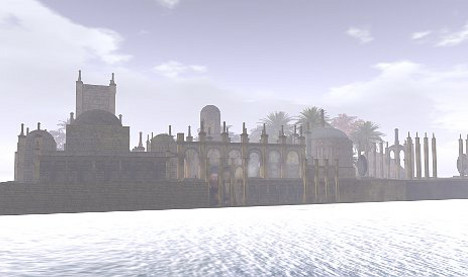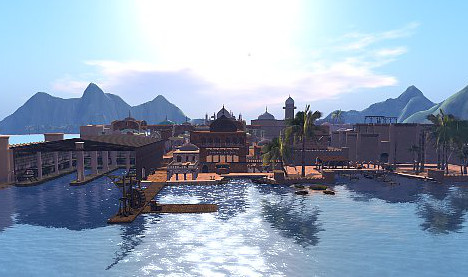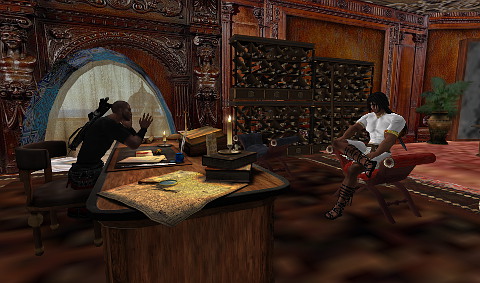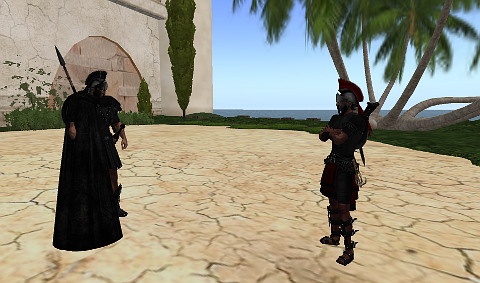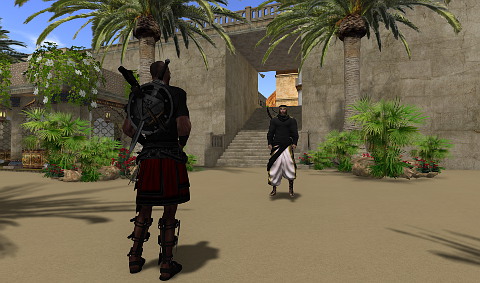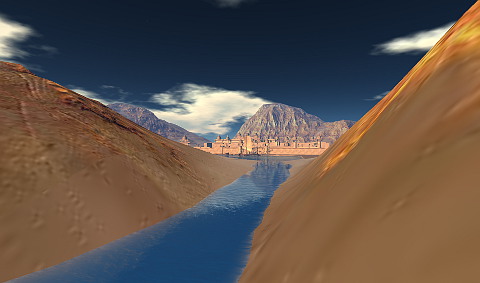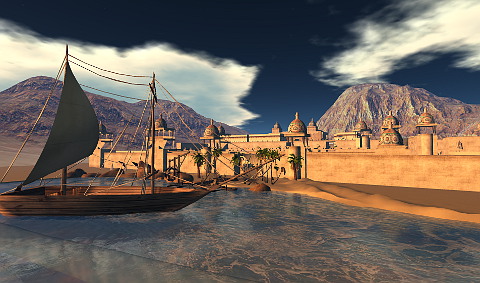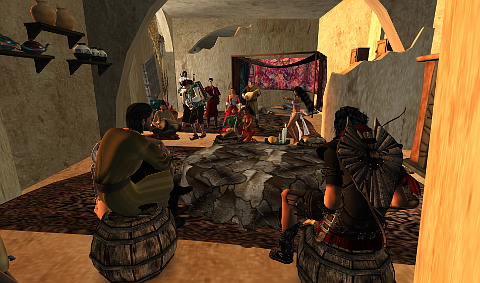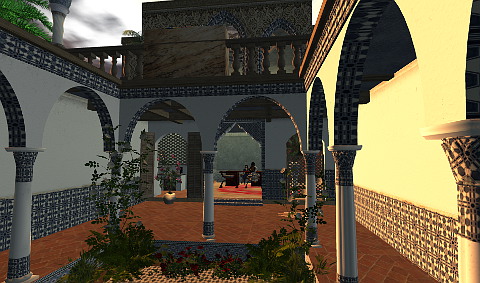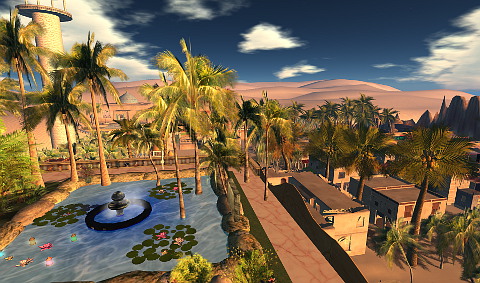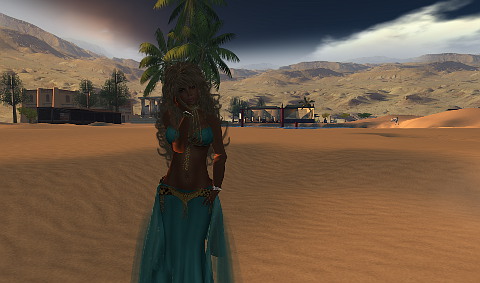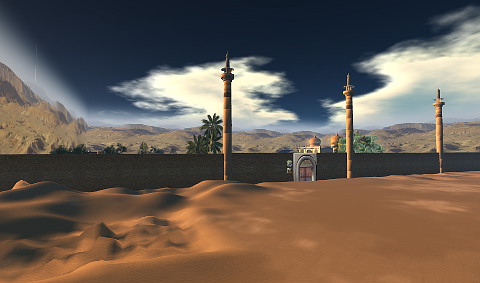Archive for August, 2016
New Administrator of Ianda on the Isle of Landa
Friday, August 19th, 2016Ianda appointed a new administrator, his name is Markus Attilius Flamma.
From above: Arguing with the head merchant Rarius Yuroki. Talking with a killer. Negotiating with the Pasha of Teehra.
Teehra, Fayeen river
Saturday, August 6th, 2016Approaching Teehra, near the Fayeen river and the ruins of old Kasra.
The Tahari region is located southeast of Ar, below the eastern foothills of the Voltai Mountians. This area is shaped like an enormous, lengthy trapezoid with eastward leaning sides. At the northwest corner of this region is the opulent city of Tor. Further west of Tor, on the Lower Fayeen River, is the city of Kasra. The desert area in the middle is known as the Wastes or the Emptiness. This area is hundreds, or even thousands, of pasangs wide. It is mostly rocky and hilly except for the dune country area. A hot wind blows nearly constantly there and water is very scarce. There are some oases that are fed from underground rivers, tributaries that flow from the Voltai.
Oase der Zwei Scimitare
Saturday, August 6th, 2016Oasis of Two Scimitars (german Oase der zwei Scimitare), the crowded tavern, musicians playing.
Little is mentioned about this oasis. We do know that it is an isolated and obscure oasis, far from the established trade routes, that is under the control of the Bakahs who were once a vassal tribe of the Kavars.
City of Tor and its outskirts
Saturday, August 6th, 2016Negotiating with Doc Grun, Vizier, former High Pasha of the Oasis of Nine Wells, in the City of Tor.
Much of the city, of course, was organized to support the caravan trade. There were many walled, guarded warehouses, requiring their staffs of scribes and guards, and, in hundreds of hovels, lived kaiila tenders, drovers, and such, who would, at the caravan tables, when their moneys had been exhausted, apply, if accepted, making their mark on the roster, once more for a post with some new caravan. Guards for these caravans, incidentally, were usually known by, and retained by, caravan merchants between caravans. They were known men. Tenders and drovers, on the whole, came and went. Elaborate random selection devices, utilizing coins and sticks, and formulas, were sometimes used by merchants to assure that applying tenders and drovers were selected, if they were not known, by chance. Tenders and drovers were assured that this was to insure fairness. Actually, of course, as was well known, this was a precaution against the danger of hiring, en bloc, unwittingly, an organized group of men, who might, prior to their hiring, have formed a plan to slay the guards and merchants and make off with the caravan. Tenders and drovers, however, like men generally, were an honest sort.
Tor, rather similarly, (to the oasis) though few crops were grown within its walls, was built high, about its water, several wells in the deepest area in the city. The architecture of Tor, in concentric circles, broken by numerous, narrow, crooked streets, was a function of the radius from its wells. An advantage of this municipal organization, of course, though it is scarcely a matter of intentional design, is that the water is in the most protected portion of the city, its center.
These buildings, on the outside smooth and bleak, save for occasional narrow windows, high, not wide enough to admit a body, abut directly on the streets, making the streets like deep, walled alleys. In the center of the street is a gutter. It seldom rains in Tor, but the gutter serves to collect waste, which is often thrown into it, through open doors, by slaves. Within these walls, however, so pressing upon the street, I knew there were often gardens, walled, well-watered, beautiful, and cool, dark rooms, shielded from the heat and sun, many with superb appointments.
The buildings of Tor are of mud brick, covered with colored, often flaking, plasters. But now, in the sun, and the dust, raised by the people in the streets, everything seemed drained of color.
Tor was, as Gorean cities went, rich, trading city. It was headquarters for thousands of caravan merchants. In it, too, were housed many craftsmen, practicing their industries, carvers, varnishers, table makers, gem cutters, jewelers, carders, dyers of cloth, weavers of rugs, tanners, makers of slippers, toolers of leather, potters, glaziers, makers of cups and kettles, weapon smiths, and many others. Much of the city, of course, was organized to support the caravan trade.
Tor, lying at the northwest corner of the Tahari, is the principal supplying point for the scattered oasis communities of that dry vastness, almost a continent of rock, and heat, and wind and sand.
(from “Tribesmen of Gor”)
Oasis of Sand Sleen, revisited
Saturday, August 6th, 2016The Kavar Oasis of Sand Sleen and the First Girl Devilssabre.
The Kavar is the other major tribe of the Tahari and is often at odds with the Aretai. Their vassal tribes are the Ta’Kara, Bakahs, Cha,r and Kashani. Their war cry is ‘Kavars Supreme!’. Their mark is a blue scimitar facing outward from the body on the right forearm. Weapons include the Weapons sleeve dagger and scimitar.
The major tribes were ruled by Pashas. The Pasha often resided in a Kasbah, the fortress.
Men also wear the kaffiyeh and the agal. The kaffiyeh is a squarish scarf, folded over into a triangle, and placed over the head. Two points of it are placed at the side of the shoulders. One is placed in the back to protect the back of the neck. It is bound to the head by the agal, several loops of cord. The cording indicates a person’s tribe and district in the Tahari region. Some men, generally in the cities, may wear a head scarf, a wrapped turban of rep cloth. This protects the head from the sun and does not permit sweat to escape. Among lower-caste men, it can also provide a soft cushion for boxes and other burdens. You simply steady the burden with your right hand. In doors, men commonly wear soft, heel-less slippers with extended, curling toes.
Slave girls in the Tahari often wear chalwars. These are baggy pants of diaphanous silk, gathered in closely at the ankles. They are worn low on the hips, several inches below the belly button. They are similar to the harem trousers of the middle east region of Earth. They may also wear a silk vest with the chalwars.
